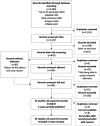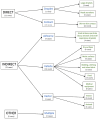It's not just droplets: a systematic review and meta-analysis of the modes of transmission of Group A Streptococcus
- PMID: 40977801
- PMCID: PMC12443793
- DOI: 10.3389/fpubh.2025.1630054
It's not just droplets: a systematic review and meta-analysis of the modes of transmission of Group A Streptococcus
Abstract
Background: The transmission of Group A Streptococcus (Strep A) through respiratory droplets has been considered the dominant mode of transmission to date; however, little is known about the relative contribution of other modes of transmission. This review systematically summarises the contemporary evidence regarding the transmission of Strep A.
Methods: A comprehensive search strategy was implemented to identify studies on Strep A transmission published in English between 1980 and 2019. Full-text articles were screened and included based on the predefined criteria. Studies were included if molecular techniques were used to identify the same Strep A strain in both clinical and environmental swabs. A random-effects meta-analysis model was used to aggregate attack rate estimates with 95% confidence intervals (CI), incorporating the Freeman-Tukey transformation to account for variability between studies.
Results: A total of 34 transmission cohorts were included in this study. The overall attack rate of Strep A was 18.4% (95% CI, 13.1-24.2%, I2 = 95.9%), for direct contact, it was 20.5% (95% CI, 8.3-35.4%), and for indirect contact, it was 19.1% (95% CI, 13.2-25.7%). When pooled by geographical location, the attack rate was 30.38% (95% CI, 20.89-40.75%) in non-urban settings and 7.36% (95% CI, 2.60-14.21%) in urban settings.
Conclusion: Direct contact is no longer the dominant form of Strep A transmission. Our contemporary findings have implications for the development of evidence-based environmental health strategies aimed at reducing Strep A transmission.
Systematic review registration: https://www.crd.york.ac.uk/PROSPERO/view/CRD42019138472, CRD42019138472.
Keywords: Group A Streptococcus; environmental health; epidemiology; infectious diseases; meta-analysis; primordial prevention; systematic review; transmission.
Copyright © 2025 Barth, Daw, Enkel, McRae, Carapetis, Wyber, Bowen and Engel.
Conflict of interest statement
The authors declare that the research was conducted in the absence of any commercial or financial relationships that could be construed as a potential conflict of interest.
Figures





References
-
- Lemon HM, Loosli CG, Hamburger M, Jr. Transmission and control of respiratory diseases in army barracks: II. The spread of haemolytic streptococcal infections among enlisted personnel. J Infect Dis. (1948) 82:72–85. - PubMed
-
- Cordery R, Purba AK, Begum L, Mills E, Mosavie M, Vieira A, et al. Frequency of transmission, asymptomatic shedding, and airborne spread of Streptococcus pyogenes in schoolchildren exposed to scarlet fever: a prospective, longitudinal, multicohort, molecular epidemiological, contact-tracing study in England, UK. Lancet Microbe. (2022) 3:e366–75. doi: 10.1016/S2666-5247(21)00332-3, PMID: - DOI - PMC - PubMed
Publication types
MeSH terms
LinkOut - more resources
Full Text Sources
Medical

